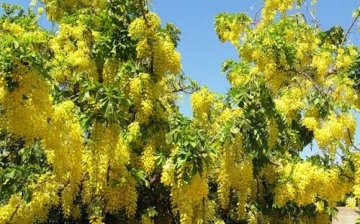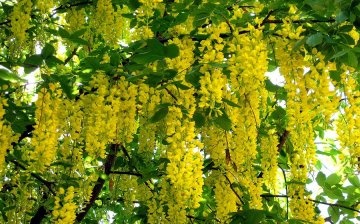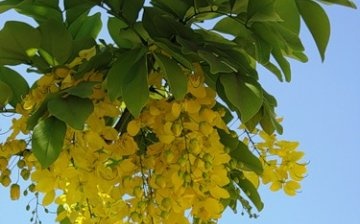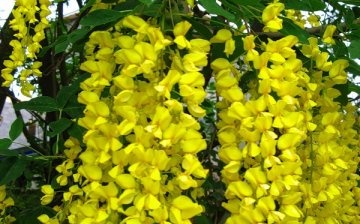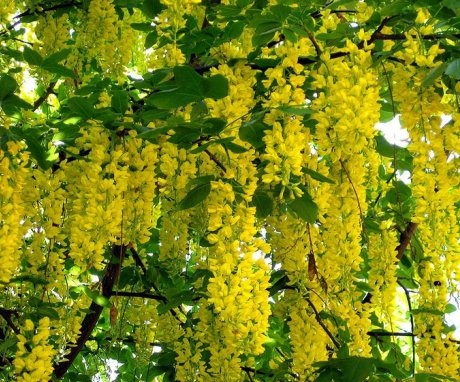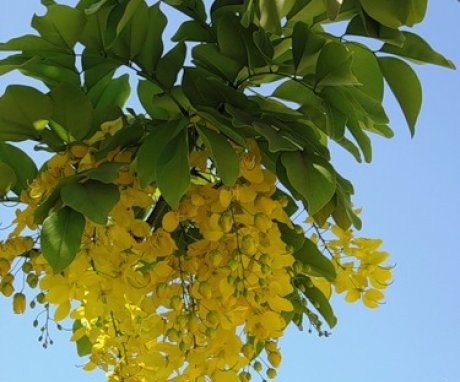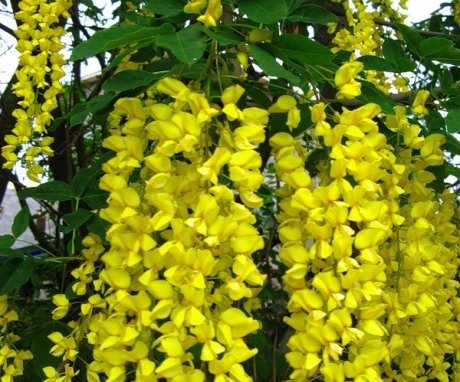Bobovnik in the photo. Growing bean
Legume, legume (Laburnum) or broom, in the photo resembles golden rain, as it is usually called. Golden rain will decorate your site and will attract the eyes of all passers-by.
Content:
This is a weeping ornamental tree, the flowers of which, in yellow beautiful large clusters, reaching a length of 30-50 centimeters, droop down. Sometimes there are plants with white and pink flowers. Legume flowers are characterized by a pleasant aroma. Flowering begins in mid-May and lasts about a month.
After flowering, dense beans appear on the plant, which contain flat shiny seeds. It is better to remove the fruits in order to get abundant flowering next year.
Diversity
There are 3 types of bean and many varieties.
In central and southern Europe, this tree can reach a height of 7 meters, but sometimes it remains low (up to 0.5 meters), and is often found in parks and gardens.
Usually broom leaves are trifoliate and are light green in color. Some varieties are characterized by golden or oak-like leaves.
Breeders have developed a decorative bean form, which they called "autumn". Its peculiarity is re-flowering in the fall.
Spread
The homeland of the broom is Crimea, the Caucasus and Central Asia. Here the plant feels great and can reproduce by self-seeding. Now golden rain is common in the south and center of Europe. Introduced to Russia and Ukraine at the beginning of the 19th century.
Using
Basically, the legume is grown as an ornamental plant. It can often be seen in city parks. Prefers single or group plantings. With linear planting, the decorative effect of the plant is lost. Looks great with conifers, wisteria, colquition, hawthorn, heather, chubushnik, skumpia and rhododendrons... It is a honey plant.
Souvenirs, sculptures, inlays and musical instruments are made from beanwood, which has a beautiful color, peculiar texture and durability. Previously, the plant was used to make arcs for bows and crossbows.
Cytisine, which is part of the bean, has a similar effect to nicotine. During the First World War, it was used for making hand-rolls. But smoking the leaves of this plant often leads to nausea and vomiting.
Now, broomsticks are used to prepare homeopathic remedies and remedies to help quit smoking.
Landing
The soil these plants like light and well-drained, with the addition of lime. But they can grow well on rocky and sandy soil.
Planting is best done in spring. A seedling, a support rail is placed in the hole and water is poured. It is necessary to add humus, compost and lime to the hole. The seedling is covered with earth and tamped. The trunk is tied to a support pole, and the trunk circle is mulched.
The bean plants are planted in sunny places, sheltered from cold winds. In the shade, the leaves crumble and flowering becomes weak. If you plant legumes in the wind, then you may not see the flowers at all.
Reproduction
Leguminous plant propagates by seeds and vegetatively. The easiest way to grow a plant is from seeds that are taken from a plant that has already acclimatized in the area.Instead of prolonged stratification, the seed rind is simply rubbed with sandpaper or treated with sulfuric acid for half an hour. It is better to sow in spring. Seedlings usually bloom in the third year.
The plant also propagates by layering. In spring, shoots should be covered with earth and left until next year. The following spring, the rooted shoots are transplanted to a permanent place.
You can use the division of the bush. Hybrid varieties are propagated by cuttings and grafting.
Pests and diseases
Leaves, flowers and beans contain toxic substances - dangerous alkaloids: cytisine and laburnine. Bobovnik is one of the most poisonous European plants.
If a child eats 2 seeds, he may die. Therefore, growing legumes is not recommended for those with small children. But due to its toxicity, the legume is resistant to diseases and pests.
May be affected by powdery mildew in warm and humid conditions. To combat it, biological fungicides are used.
Bean Care
Unfortunately, the legume is not winter-hardy, therefore, its cultivation is not so widespread in the middle lane. In our cold winters, the legume often freezes over. True, then it grows back, but it does not bloom as abundantly and beautifully as the bean in the photo. Therefore, it is recommended to cover the plant for the winter.
During heavy snowfall, it is necessary to shake off the snow from the bushes so that the branches do not break.
Care should be taken to weed the bean, as its roots are on the surface.
The plant needs watering only during dry times, and feeding - in early spring (nitrogen fertilizers) and late autumn (phosphorus-potassium). In order to keep the legume in a decorative state, in early spring, when the buds swell, it is pruned, removing dried, as well as old and diseased branches.
Sometimes the plant is used as a canopy, in which case formative pruning is needed. But only young plants are subject to such pruning, for adult plants such a procedure is too painful.
Bobovnik is characterized by resistance to gases and smoke. The plant feels great on the territory of industrial enterprises. In favorable conditions and with good care, this beautiful tree lives for about a hundred years.



